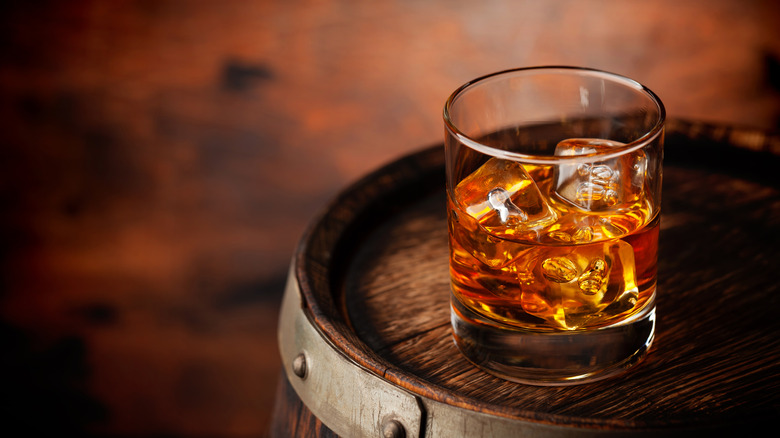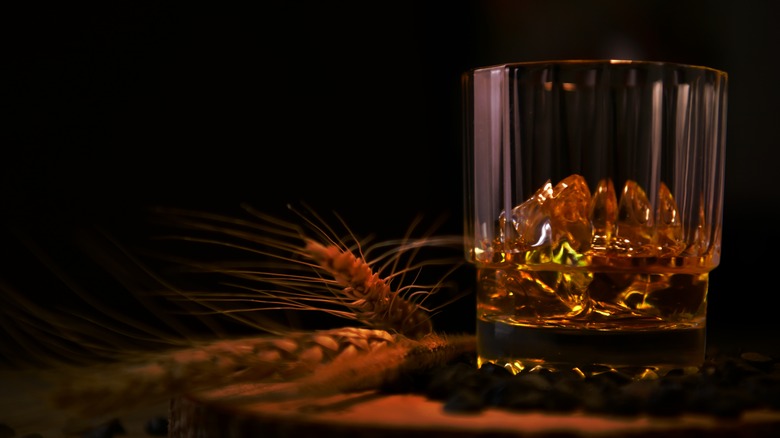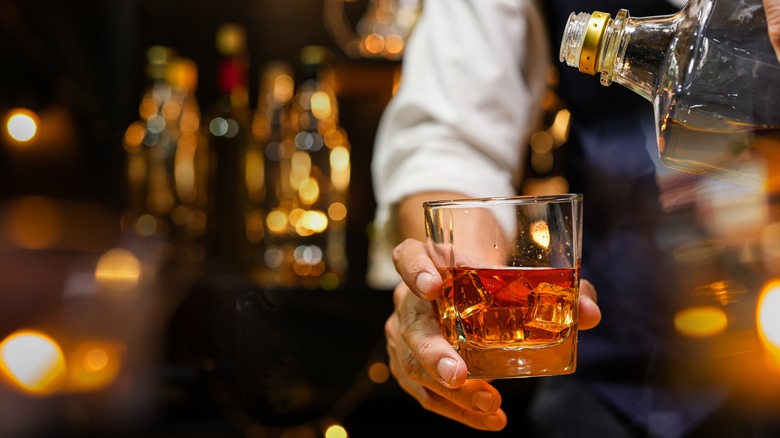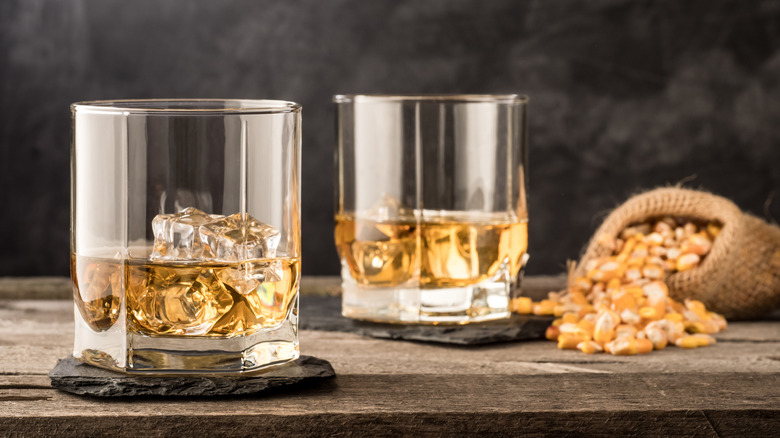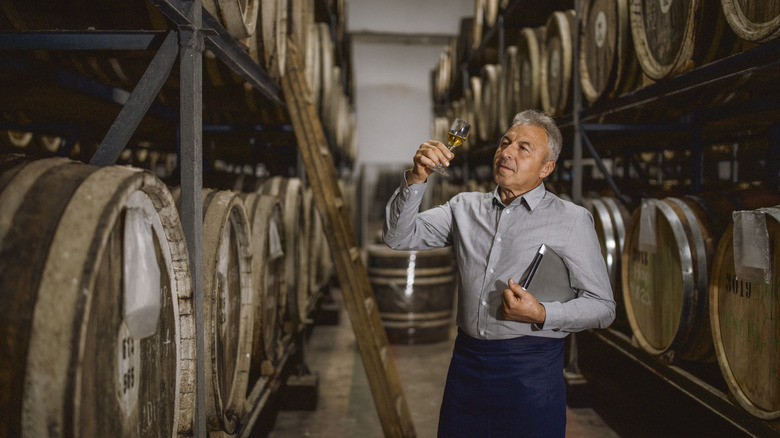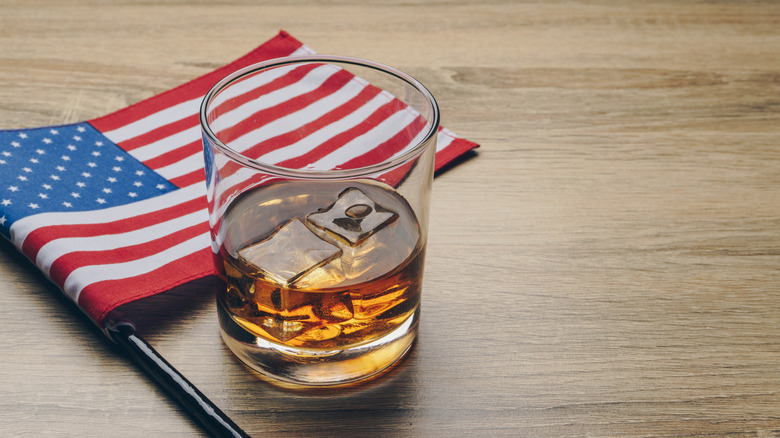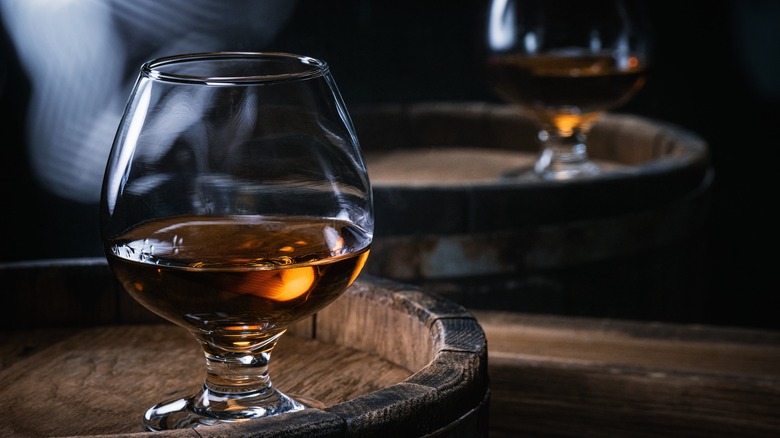The Difference Between Bourbon And Whiskey
You may have heard about the bourbon boom in the United States, with bourbon production reaching peaks that haven't been seen since the early 1970s, when consumers began turning more towards vodka and tequila. Younger generations have rediscovered a love of bourbon, which is driving up sales. This shift is being fueled by the rise of craft products like barrel-proof and small-batch bourbons.
Whiskey is now the most popular spirit in the United States, ending vodka's decades-long reign and taking back a title that whiskey hasn't enjoyed since before World War Two. Its decline started with Prohibition, and its fate was sealed when distillers were forced to produce industrial alcohol for the war effort, after which consumer preferences turned towards more readily available spirits like rum.
Bourbon is becoming more popular, and whiskey is king, but what's the difference between them? Put it this way: All bourbon is whiskey, but not all whiskey is bourbon. Bourbon is a type of whiskey, and the term whiskey applies more generally to a group of spirits that include Scotch whisky, Irish whiskey, Canadian whisky, Japanese whisky, and so on. Bourbon falls under the category of American whiskey, but there's a lot more to the story than just where it's from.
What is whiskey?
In simple terms, whiskey is a distilled spirit made from fermented grain. These grains include barley, wheat, corn, and rye. Whiskey is aged in wooden barrels called casks, which are often toasted or charred beforehand. The spirit is clear when it's first fermented but later takes on its dark amber color from the cask itself. Although the flavor of the whiskey changes from brand to brand and from batch to batch, the general taste is warm, spicy, and sweet.
The history of whiskey is highly contested, but it originated in either Scotland or Ireland in the 14th or 15th century. The first written record of whiskey production can be found in a 1494 document called the Scottish Exchequer Rolls. At that time, alcoholic spirits were called aqua vitae, which is Latin for "water of life." In the document, the king ordered several bushels of malt for the production of aqua vitae. Since malt is made from grain, it's clear that the Scottish king was making alcohol from fermented grain, which makes this particular aqua vitae what we today call whiskey.
There are earlier references to aqua vitae, which indicate a longer history of distillation in the area. However, since aqua vitae was a general term used to refer to all alcoholic spirits, there's unfortunately no clear way to distinguish the whiskey from the wine. In Gaelic, aqua vitae was called uisge beatha. The word "whiskey" is thought to stem from the phonetic pronunciation of the word "uisge."
What is bourbon?
Bourbon came into existence much later as an American variety of whiskey. As with whiskey varieties in general, pinpointing the exact date when bourbon was invented is a difficult task. Americans were experimenting with corn-based alcoholic drinks in the early 1600s, but it wasn't until the late 1700s that Elijah Craig began distilling. Craig was the entrepreneurial frontiersman who was controversially dubbed the father of bourbon. Whiskey scholars are highly skeptical of Craig's claim to fame. He was a successful Baptist minister and, although he may have been distilling bourbon around the time of its invention, there's reason to believe that other, less famous individuals were responsible for the actual birth of bourbon instead.
The history of bourbon could fill several books, and it's a story worth telling, but suffice it to say that bourbon has grown to become the most successful variety of whiskey in the U.S. As for modern history, the bourbon boom of the 21st century is due in no small part to the rise of craft whiskey, and there's a strong argument for crediting that shift to the 1984 release of Blanton's. Released by Buffalo Trace Distillery, Blanton's was the very first single-barrel bourbon produced commercially. Although many deride the hype surrounding Blanton's today, the lengths consumers will go to get their hands on a bottle attests to its staying power.
The mash bill
Knowing the history of bourbon and whiskey doesn't actually tell us anything about how bourbon is different from other whiskeys. There are a number of ways to tell whiskeys apart, and they all essentially come down to the recipe card. The first thing you look at with any recipe is the ingredient list. For whiskey, the ingredients are called the mash bill.
Bourbon's mash bill is required by law to be at least 51% corn, and the law also stipulates that nothing may be added to the bottle that affects the taste or color. Most bourbons will have anywhere from 60%-86% corn, followed by some mixture of barley and rye. Wheated bourbons will replace the rye with wheat for a softer, less spicy bourbon.
Describing whiskey mash bills is difficult because they vary so much. The second-most popular American whiskey, rye whiskey, is made from 51% rye, with the rest being a combination of corn, wheat, or barley. Single malt Scotch whisky is made with 100% malted barley. Pot still Irish whiskey is made from 30% malted barley and 30% unmalted barley. The list goes on, but you get the idea. Although there are other factors contributing to the taste, the mash bill plays a key role in determining what a whiskey tastes like.
Bourbon has strict aging requirements
Arguably even more important than the mash bill when it comes to flavor is the aging process. Once the mash bill has been fermented, the end result gets placed inside casks to age. Not all whiskeys are aged, but the vast majority of them are. The different vectors for aging include the type of wood the cask is made out of, how that wood is treated before the whiskey is poured in, and how much time the whiskey spends in the barrel before being bottled.
Bourbon is legally required to be aged in charred oak barrels for a minimum of two years. The barrels have to be new, meaning they've never been used to age whiskey before and are made specifically from white oak. Charring a barrel means the inside of it is torched with fire, producing a layer of char that's anywhere from ⅛ inch to ¼ inch thick. High-shelf bourbons are typically aged for 5 to 12 years, well above the legal requirement.
The most common woods used to age whiskey are American white oak and European oak. In terms of flavor, European oak is known to produce a bourbon that is a little spicier than the American equivalent. When the wood is not charred, it is instead toasted. Toasted barrels are still treated with fire, but not enough to produce a layer of char. Some whiskeys allow barrels to be used multiple times. For example, Scotch barrels can be used up to three times.
Bourbon is from America
Bourbon was the product of American frontiersmen looking to create a quality spirit out of corn. In 1964, the U.S. Congress dubbed bourbon America's native spirit, and this wasn't just grandstanding. Bourbon is required by law to be made in the United States in order to be called bourbon, much like how Scotch is only allowed to be made in Scotland.
Some people are under the impression that bourbon is even more regionally specific and that it can only be made in Bourbon County, Kentucky, but that's not true. Although 95% of all bourbon is made in Kentucky, the other 5% is made elsewhere in the U.S. and is still allowed to call itself bourbon. There are also other American whiskeys that could call themselves bourbon since they meet all the requirements but choose not to. The most prominent example of this would be Jack Daniel's Tennessee Whiskey.
Interestingly enough, whiskey is nearly always categorized according to where it's produced. There are Japanese whiskys, Irish whiskeys, and so on. Within those categories, there are subcategories. Irish whiskey can be broken down into groups like Irish single malt and Irish single pot still. Whiskey is a general catch-all term, so it isn't tied down to any one location, and can be made anywhere in the world.
Bourbon tends to be stronger
When we talk about the strength of a spirit, we're talking about the proof, which is a measure of the alcohol by volume, or ABV. If a batch of whiskey is 40% ABV, it's considered 80 proof. The math is simple; you just double it. To go back down, divide it in half. A 100-proof bottle is therefore 50% ABV.
Before the recent bourbon boom began, you would typically find bourbons between 80 and 100 proof. Legally, bourbon is required to be at least 80 proof but can't be bottled at more than 150. Now that we have barrel-proof and cask-strength products, we're seeing plenty of bourbons reach 120, 130, and sometimes even 140 proof.
Other whiskey varieties generally aren't that strong, though some distillers are taking notice of the high-proof trend happening in the bourbon world. Scotch producers, for example, are coming out with cask-strength scotch. A high-proof scotch will be around 115 proof, which is a significant drop from the peaks bourbon can reach. Irish whiskey is about the same, with a high-proof version coming in at 110 to 115 proof. Canadian whisky, on the other hand, can compete with bourbon. Canadian whisky doesn't have as many proof restrictions during distillation, so you can find Canadian whiskys that are in the 130 and 140 range pretty easily. In general, though, most whiskeys hover around 80-100 proof.
Bourbon is sweet
Although knowing the history of whiskey is cool and nerding out about how it's made can be fun, what really matters is how it tastes. Believe it or not, no one is buying a bottle of whiskey just so they can read the label. Bourbon is known for being sweeter than most whiskeys with notes of caramel and vanilla. The corn in the mash bill provides a lot of the sweetness, and the charred oak gives it the flavor of warm spices.
Talking about how whiskey tastes in a general sense is pretty tough since there is just so much variety, but if you paint with a very broad brush, you could say that whiskey is spicy and oaky with notes of vanilla. Depending on what grain was used, what barrels it was stored in, and how long it was aged for, the general flavor profile can vary wildly. That makes the spirit fun because no two whiskeys are exactly alike.
